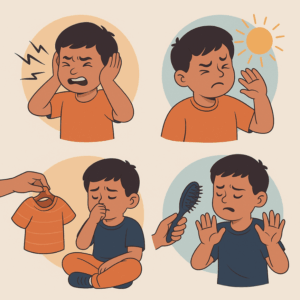Sensory Issues in Autism: Understanding the World Through Their Senses
 🔍 What Are Sensory Issues in Autism?
🔍 What Are Sensory Issues in Autism?
Many children and adults with Autism Spectrum Disorder (ASD) experience the world very differently—through heightened or reduced sensitivity to sights, sounds, smells, tastes, touch, and movement. These are called sensory processing differences.
They’re not behavioral problems. They’re neurological in origin. And they often explain meltdowns, refusal, or what may appear to be “stubbornness.”
🧠 How Sensory Processing Works in Autism
Sensory input is like information from the environment. In autistic individuals, the brain may:
-
Overreact (hypersensitivity) – Loud sounds, bright lights, or scratchy clothes may feel unbearable.
-
Underreact (hyposensitivity) – They may not notice pain, feel the need to touch everything, or seek strong movement (rocking, spinning).
-
Struggle to integrate input – Difficulty coordinating sight, sound, and touch together, leading to disorientation or anxiety in crowds.
This affects behavior, learning, mood, and social functioning.
🧩 Common Sensory Challenges in Autism
| Sensory Domain | Example Challenges |
|---|---|
| Auditory | Covering ears, reacting to vacuum cleaners or school bells |
| Visual | Avoiding eye contact, being distracted by flickering lights |
| Tactile | Refusing certain clothes, not liking hugs, toe walking |
| Olfactory/Gustatory | Picky eating, gagging at smells or certain textures |
| Vestibular | Fear of swings or escalators, craving spinning |
| Proprioception | Clumsiness, crashing into things, difficulty judging force |
❤️ What Parents Often Miss
-
Sensory issues are not attention-seeking
-
They can be misinterpreted as behavioral defiance
-
Even children with good language skills may lack the words to describe the discomfort
-
These issues often precede meltdowns, shutdowns, or aggression
🛠️ Sensory Strategies and Remedies
-
Sensory Profile Assessment
Occupational therapists can assess your child’s sensory preferences using structured tools. This forms the basis for an intervention plan. -
Sensory Diet
A planned set of activities (e.g., jumping, brushing, fidget toys) given throughout the day to help regulate the child’s nervous system. -
Environmental Modifications
-
Use noise-cancelling headphones
-
Dim lighting or avoid fluorescent bulbs
-
Tagless clothing and soft fabrics
-
Create calm-down corners at home or school
-
-
Gradual Desensitization
Slowly introducing the sensory stimulus in a non-threatening way. For example, touching different textures using a game format. -
Deep Pressure Activities
Weighted blankets, firm hugs (with permission), or compression garments can soothe hyperactivity or anxiety. -
Predictable Routines
Reduce unexpected sensory overload by maintaining structure and transitions with visual cues. -
Teach Coping Strategies
-
“When it’s loud, I can cover my ears.”
-
“I can ask for a break.”
Social stories or visual charts help.
-
💬 Real-Life Example
Meera, a 6-year-old with autism, would cry and refuse to wear shoes every morning. Her parents thought she was being difficult. A sensory assessment revealed tactile defensiveness—she was hypersensitive to certain textures. Switching to soft cotton socks and a deep-pressure routine made mornings peaceful again.
🌱 Why This Matters
Untreated sensory issues can lead to:
-
School refusal
-
Avoidant behavior
-
Emotional dysregulation
-
Social isolation
Addressing sensory needs improves learning, attention, and emotional health.
📍 Dr. Srinivas Rajkumar T
Consultant Psychiatrist – Child, Adolescent & Geriatric Psychiatry
Apollo Clinics Velachery & Tambaram | Mind & Memory Lab
🌐 www.srinivasaiims.com | 📞 +91 85951 55808
Offering sensory profiles, parent training, and neurodevelopmental evaluations.